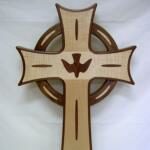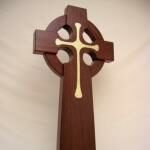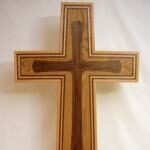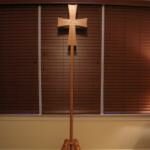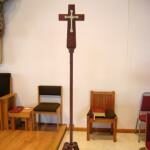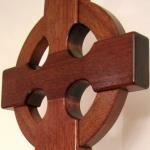I came up with the idea of making wooden crosses and Irish Celtic wall Crosses after my mother returned home from a trip to Ireland. I gave many of them as gifts to my family and they liked them so much that I decided to market them to the general public.
Over the years, after making those first few 16 inch Celtic wooden crosses, the work has seemed to grow and evolve into larger sizes and with inlay work.
I use many of the same tools my father used to make my wooden crosses. There are times when I pick up an old chisel or plane that my father used and it seems to have his skill honed into it from over the years when he used them. I love that feeling. My first original 16 inch wood celtic wall crosses that I started making can still be found and ordered by contacting me through this web site.
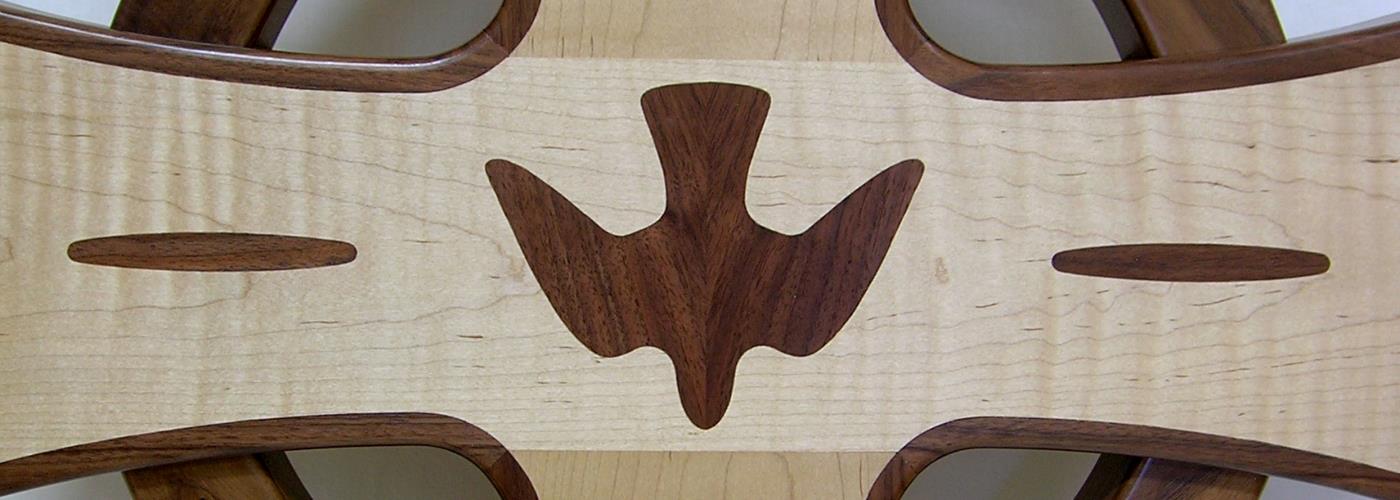
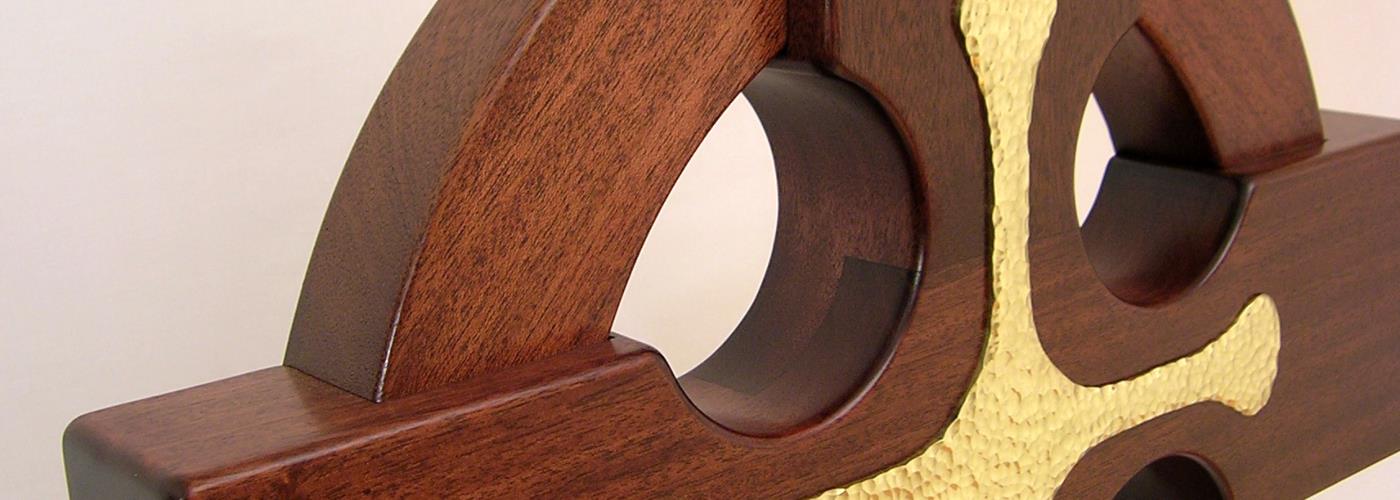
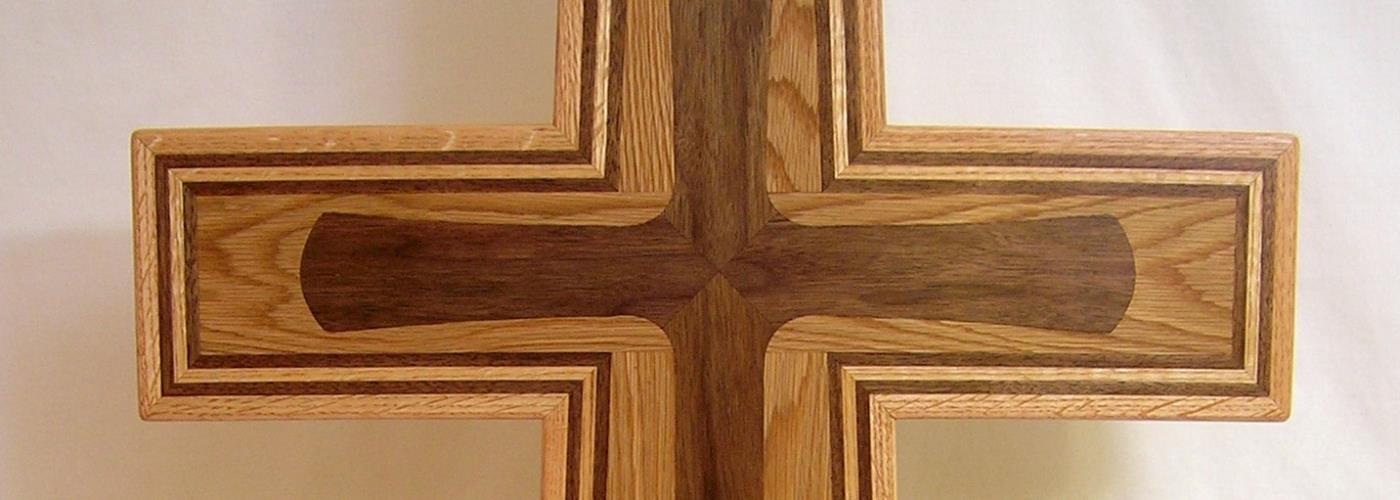
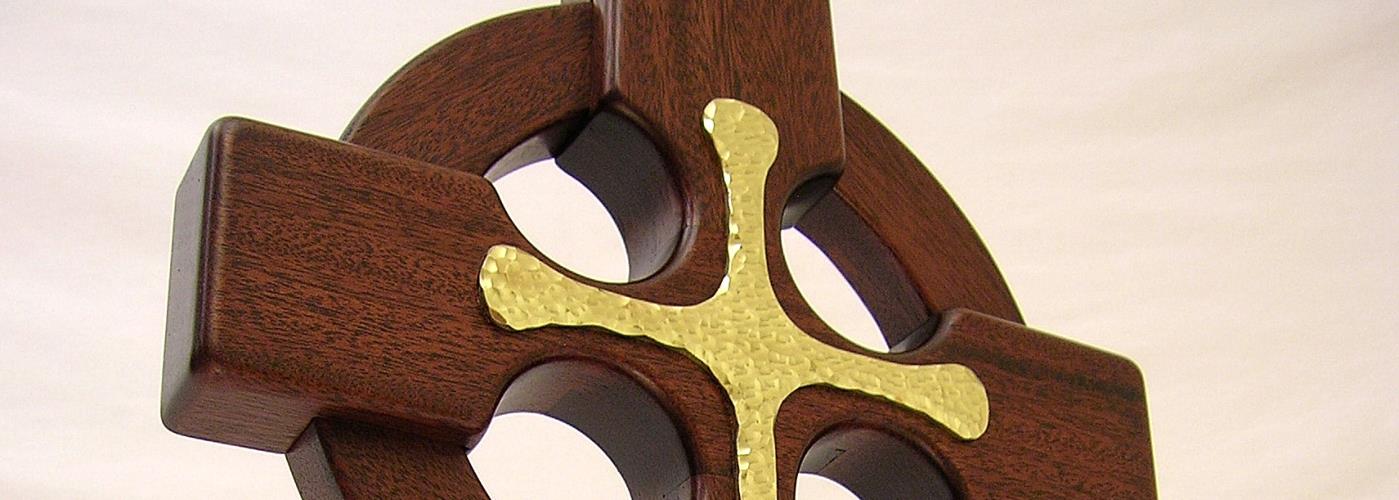
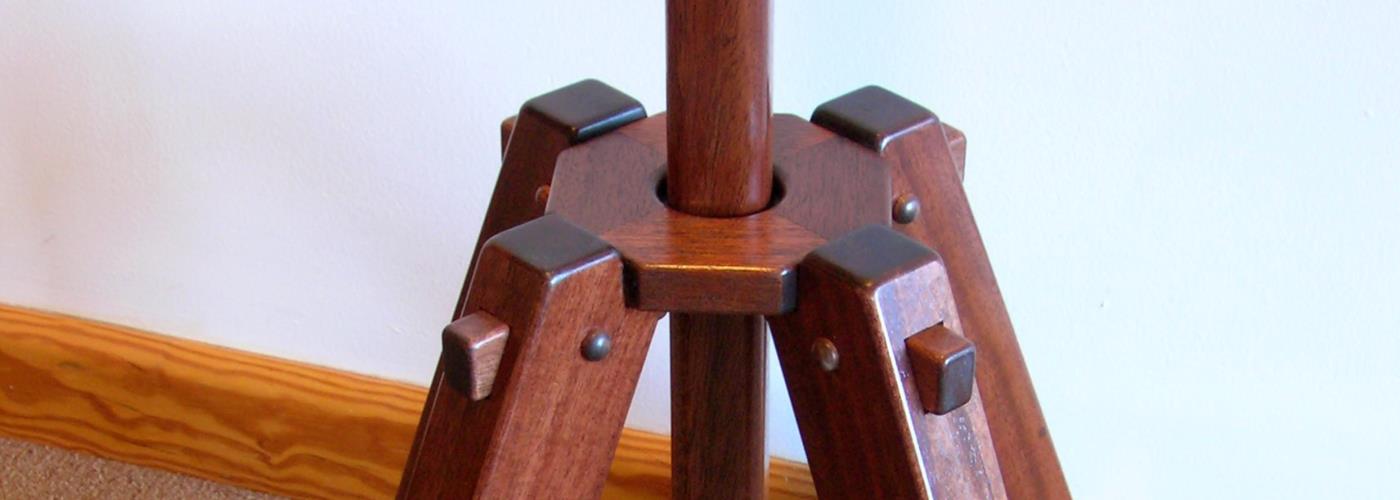
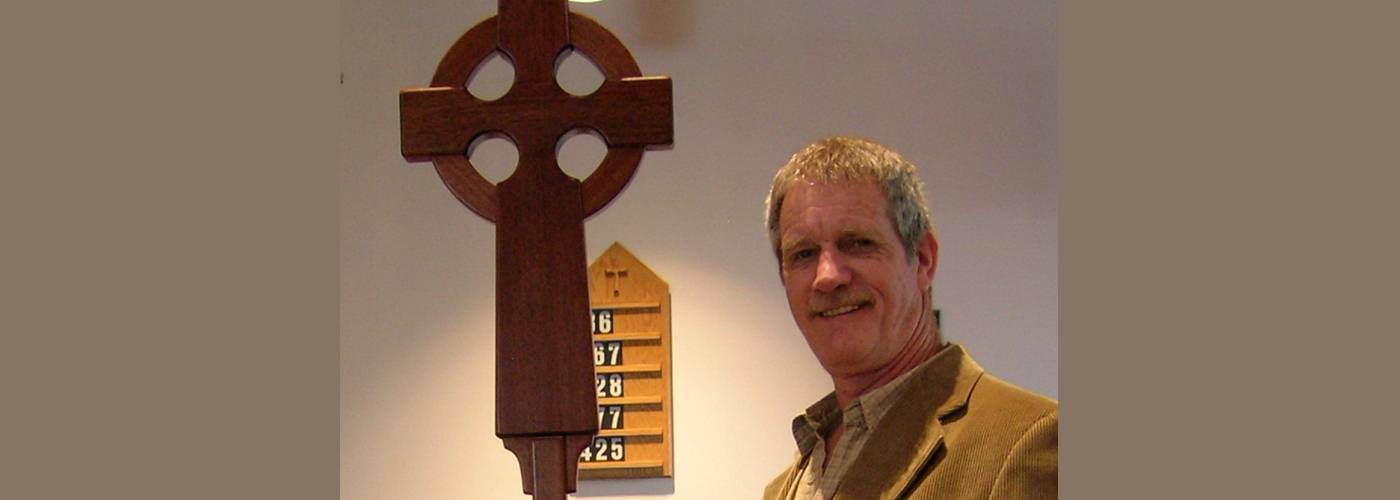
Joseph Wooden Crosses
My wall crosses include Celtic and Latin Crosses and range from 1 to 4 feet. Some of my wooden crosses feature brass or bronze inlays and all include the wall hanger.
My processional crosses include Celtic and Latin Crosses. Some of my wooden crosses feature brass or bronze inlays and all include the matching stand.
The Celtic Cross, Inspiration for many wooden crosses
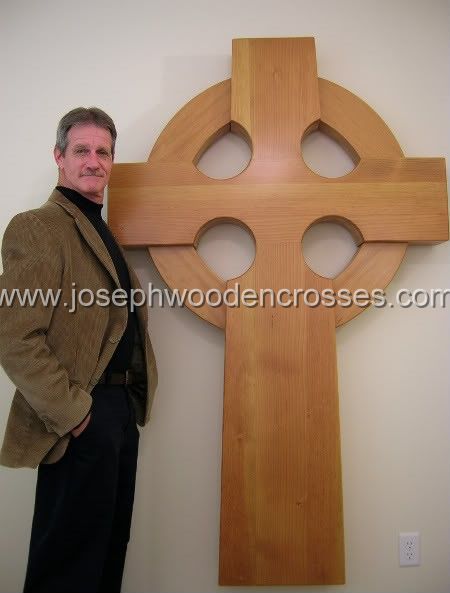 A Celtic Cross is a religious christian cross with a circle around the center where the vertical and horizontal lines intersect. It is essentially a Latin cross, with a circle enclosing the intersection of the upright and crossbar. At times it may be referred to as an “Irish Cross” or “Irish Celtic Cross”. More commonly, they are known as a “Celtic Cross” as it is associated with all people of celtic heritage, not just Irish. The Scottish, Welsh, Cornish, Galician, Manx, Breton and other regions of Anglican People that were influenced by early christianity and celtic heritage, such as Episcopalian, Presbyterian, Baptist, Lutheran, Methodist, Catholic, utilize the Celtic Cross.
A Celtic Cross is a religious christian cross with a circle around the center where the vertical and horizontal lines intersect. It is essentially a Latin cross, with a circle enclosing the intersection of the upright and crossbar. At times it may be referred to as an “Irish Cross” or “Irish Celtic Cross”. More commonly, they are known as a “Celtic Cross” as it is associated with all people of celtic heritage, not just Irish. The Scottish, Welsh, Cornish, Galician, Manx, Breton and other regions of Anglican People that were influenced by early christianity and celtic heritage, such as Episcopalian, Presbyterian, Baptist, Lutheran, Methodist, Catholic, utilize the Celtic Cross.
The history of the Celtic Cross as a symbol of christianity, as we know it today, is wide with a variety of interpretations as to it’s original meaning. The first crosses associated with christianity were Latin Crosses which appeared around the 2nd century. The first Irish Cross or Celtic Cross used as a symbol for christianity by the Celts was not until the early middle ages around the 5th century. To understand the history of the celtic cross it may also be helpful to know a little about the people behind it, “The Celtic People”. In earlier times, before christianity, the celtic people were already using symbols similar to the celtic cross to represent the moon and the sun. The moon was represented by a circle and the sun was represented by a circle with a cross on the inside of the circle. This is what some refer to as the Sun Cross, or Ringed Cross as used by the ancient Druids. The difference between the earlier Sun Crosses and the later christian based designs is that the image of the celtic cross that we know of today has arms that extend outside of the circle, while earlier examples of the sun cross have the cross arms completely inside the circle.
Some say that the celtic cross was derived from the Chi Rho symbol, as popularized by the Roman Emperor Constantine who made christianity the official religion of the Roman Empire. “Chi” and “Rho” are the first letters of the word “Christ” in the greek alphabet and, when these letters are interlinked, they appear similar to the cross at the center of a celtic cross. Though possible as that may be, the evidence is undetermined and is more coincidental. Most believe, and as I do, that it was not until St. Patrick came to Ireland as a missionary during the 5th century.
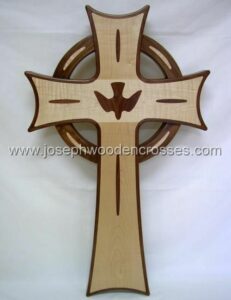 According to Irish legend, St.Patrick introduced and converted the Celtic People of Ireland to christianity by using an iconic symbol that was familiar to them by drawing a circle around the inner section of a Latin cross. There by the grace of God bringing the hope and salvation of Christ to people that had seemingly been searching for a true meaning to life. This, I believe, was the making of the first christian celtic cross.
According to Irish legend, St.Patrick introduced and converted the Celtic People of Ireland to christianity by using an iconic symbol that was familiar to them by drawing a circle around the inner section of a Latin cross. There by the grace of God bringing the hope and salvation of Christ to people that had seemingly been searching for a true meaning to life. This, I believe, was the making of the first christian celtic cross.
Celtic Crosses were often decorated in patterns and motifs of interweaving scrolls and knot work. This distinctive celtic form and style of art by the Celtic People is also referred to by historians and archaeologists as “Insular Art”. The term Insular derives from insula, the Latin term for “Island” as in Island People or Island Art. In this period, Britain and Ireland shared a largely common style different from that of the rest of Europe. In a short time, by the 8th century, the celtic cross had evolved to magnificent richly decorated christian stone monuments known as a “High Cross”.
The High Cross
The term “High Cross” is mainly used in Ireland and Scotland, but the tradition across all of the British Isles is essentially a single phenomenon. There are certainly strong regional variations. High Crosses are internationally recognized icons of early Medieval Christian times under Christian patronage. It is believed that some of the early Celtic Crosses and Religious Crosses were also made of wood with wood inlays, or perhaps with metalwork attachments and brass or copper inlays. Ravaged by the long passing of time, none of these badly worn and weathered Wooden Crosses have seemed to survive.
The two most common stones used to construct these ancient crosses were Sandstone and Granite. Some early examples of Celtic Crosses in Scotland were cross slabs, pillar crosses or Pictish stones. A good example is the Kirkyard stone in Aberlemno, “a parish and small village in Scotland”. In Scotland, the cross-slab, a flat stone with a cross in relief or incised on an essentially rectangular stone, developed as a hybrid form of the Pictish stone and the high cross. The cross is normally only on one side of the stone and the remaining areas of the stone may be covered with interlace or other decoration. These are usually distinguished from true high crosses. These stones are the most visible remaining evidence of the Picts and are thought to date from the 6th to 9th centuries, a period during which the Picts became Christianized.
Celtic Crosses and High Crosses may have marked boundaries and crossroad or medieval routes between Abbeys, Monasteries and Church sites, church crosses and other focal points for markets. High Crosses were used to mark grave sites as grave crosses, cemetery crosses, and other areas of sanctuary . In early Medieval tradition, these large crosses and sculpted stone high crosses were unique status symbols, massive and bold. Decorated in panels of relief work with vine-leaf plant forms, scrolls of interlacing key patterns, and interweaving spirals of Celtic knot work and others with motifs of both human and zoomorphic figures. The sculpted panels are thought to have been originally painted, though no traces of paint survive today. Some high crosse contained panels of significant biblical themes such as Adam and Eve, the Old Testaments and New Testaments, the Crucifixion and Resurrection of Jesus. The Crucifixion would be at the center surrounded by a traditional insular form of decorative knot work and inscriptions in Ogham “Old Irish language”.
High crosses may be dated from the inscriptions they bear but it is difficult to date the majority of the plain and undecorated high crosses. A great number of these ancient crosses were destroyed or damaged by iconoclasm after the Protestant Reformation. The Protestant Reformation was the 16th-century division between people within Western Christianity and other early Protestants. The efforts of the self-described “reformers”, who objected to and protested the doctrines, rituals and ecclesiastical structure of the Roman Catholic Church, led to the creation of new national Protestant Churches.
For more information visit the High Cross pages on Wikipedia.
A Few of the Most Notable Celtic High Crosses
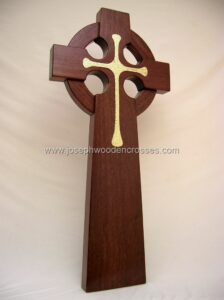
This list is not intended to be a conclusive list of medieval Celtic Crosses, High Cross, Cross Slabs, Pillar Crosses or Pictish Stones stonework. These notable celtic High Crosses provide inspiration for some of our wooden crosses.
Muiredach’s Cross
From the 10th or possibly 9th century located at the ruined monastic site of Monasterboice County Louth, Ireland. Standing at 19 ft. the Muiredach’s Cross is usually regarded as the peak of the Irish crosses and has been described as the most beautiful specimen of Celtic stonework now in existence. It is named after the Abbot Muiredach MacDomhnaill, who died in 923 and features biblical carvings of both the Old Testament and New Testament of the Bible. Muiredach’s High Cross is one of three surviving high crosses located at Monasterboice. These crosses are all made of sandstone and are referred to as the North, West, and South Crosses. Muiredach’s Cross is the south cross.
West Cross at Monasterboice
County Louth, Ireland. At 21 ft. it is the tallest cross in the country. On its west front it is ornamented with sculptured panels depicting Jesus’s life and death.
Cross of the Scriptures
At the monastery of Clonmacnoise in County Offaly, Ireland. Commissioned by King Flann Sinna, High King of Ireland or King of Tara. The term King of Tara was a title of authority in ancient Ireland and was considered an eminent authority in medieval Irish literature and mythology, though national kingship was never a historical reality in early Ireland. This 4-meter high sandstone cross is one of the most skillfully executed of the surviving high crosses in Ireland. The surface of the cross is divided into panels, showing scenes including the Crucifixion, the Last Judgement, and Christ in the Tomb.
Ruthwell Cross
Probably dating from the 8th century when Ruthwell was part of the Anglo-Saxon kingdom of Northumbria, it is now in Scotland. It is both the most famous and elaborate Anglo-Saxon monumental sculpture and possibly the oldest surviving “text” of Old English Poetry, predating any manuscripts containing Old English. It has been described by Nikolaus Pevsner a German-born British scholar of history and art, that the “The crosses of Bewcastle and Ruthwell … are the greatest achievement of their date in the whole of Europe”.
Bewcastle Cross
Still in its original position in the churchyard of St.Cuthbert’s church Bewcastle, near Carlisle, Cumbria, England. The head of the cross is missing but the remains are 14.5 feet high. The cross probably dates from the 7th or early 8th century. The theory that the cross is probably the work of a team of masons and sculptors brought in by abbot Benedict Biscop from the 670’s to expand the monastery of Monkwearmouth-Jarrow Abbey. Its formal name today is The Abbey Church of Saint Peter and Saint Paul . Benedict Biscop’s idea was to build a model monastery for England, sharing his knowledge of Roman traditions in an area previously more influenced by Celtic Christianity. Saint Paul’s, in modern Jarrow became the center of Anglo-Saxon learning in the north of England, producing the greatest Anglo-Saxon scholar, “Bede”, also referred to as Saint Bede or the Venerable Bede and his most famous works gained him the title “The Father of English History”.
Dupplin Cross
A carved, monumental Pictish stone, which dates from around 800 A.D., carved from old Red Sandstone with various scenes of both Religious and traditional Pictish animal carvings. It was placed for preservation under the 12th century tower of St Serf’s church in Dunning Scotland.
Camus Cross
An Early Medieval Scottish Cross located in Angus, Scotland. The cross is thought to date from the 10th century, and exhibits distinctive Hiberno-Scottish mission influences. According to historic literature the cross is thought to mark the burial site of a Scandinavian general named “Camus”.
Kildalton Cross
Standing in the medieval grave yard next to the ruins of an old church on the island of Islay. Carved probably in the second half of the 8th century. It is often considered the finest surviving Celtic cross in Scotland, and is certainly one of the most perfect monuments of its date to survive in western Europe. On the top are two angles, below them David fighting a lion, other panels of Abraham’s sacrifice to God. Isaac and Cain and Able and smaller intertwined serpents.
St. Kevin’s Cross
Glendaloch Ireland. St. Kevin’s Cross is a fine example of a plain cross, carved from a single granite stone. St. Kevin is known as the founder and first Abbot of the monastery at Glendalough in County Wicklow. St. Kevin was born in the year 498 to parents descended from one of the ruling families in Leinster. An angel is said to have appeared during the child’s baptism, telling his parents that the child should be named Kevin. It is said that he is the first person known to be called Kevin. As legend has it, one time during lent when St. Kevin was kneeling, his arms outstretched in prayer, a blackbird landed in his palm and built a nest. As not to disturb the bird St. Kevin remained perfectly still for the whole of Lent till the last blackbird hatchling had flown from the nest. St. Kevin was fed by the blackbird with berries and nuts. The precise location of Kevin’s grave is lost, although it is said that at dusk, when no-one is about, blackbirds will flock to an unmarked cross above a forgotten grave, the grave of a young lad who held a blackbird’s nest in his unwavering, outstretched hand for forty days.
The Gosforth cross
Located in St Mary’s churchyard at Gosforth in the English county of Cumbria. As the tallest Viking cross in England standing over 14 feet, the Gosforth Cross has elaborate carvings of Norse mythology and Christian symbolism, including a depiction of the crucifixion of Christ. The combination of Christian and Norse pagan symbolism on the cross may be evidence of the use of pagan stories to illustrate Christian teachings. Cumbria is bounded to the north by the Scotland and is characterized by invasions, battles and skirmishes between the English and Scottish. Cumbria is a mountainous area and considered one of England’s most outstanding areas of natural beauty, serving as a place of inspiration for artists, writers and musicians.
Ardboe High Cross
County Tyrone, Northern Ireland. The Ardboe High Cross is about 18.5 feet high and 3.5 feet wide and has twenty two panels of old and new testament scenes. It stands at the entrance to a monastery, from the seventeenth century which was founded in 590 by Saint Colman. The monastery was destroyed by fire in the twelfth century. The name “Arb Boe” means “hill of the cow” it comes from a wild mythical legend of how the monastery of Ardboe was built from the milk of a magic cow.
St Martin’s Cross
Standing in the front of the Iona Abbey is one of the best preserved Celtic crosses in the British Isles dated in the 9th century. The Iona Abbey is located on the Isle of Iona, just off the Isle of Mull on the west coast of Scotland. Founded in 563 by the monk Columba, now known as St. Columba, the Iona Abbey is one of the oldest and most important religious centers in Western Europe. The monastery is often associated with the distinctive Celtic practices and traditions known as Celtic Christianity and played a crucial role in the spread of Christianity to the Picts of present-day Scotland in the late 6th century and of the Anglo-Saxon kingdom of Northumbria in 635. Kings were crowned and also buried on Iona. The Book of Kells, a famous illuminated manuscript is believed to have been produced by the monks of Iona in the years leading up to 800 AD.
A close observation of these and other medieval High Crosses with all of the fine intricate detailed work, it is easy to see the great reverence and unyielding admiration of the Celtic People towards Christianity and how through their art works show a transitional period or time leading to the Christian faith. It was their way, the Celtic way, “Celtic Christianity”. I think they wanted to give their love for the Christian faith the best of best, everything they could muster up and through their artistic style they could not have done a finer job. They wanted their Christian faith to last through the ages so they cut it in stone.
More High Crosses, by the name of the cross or by name of the county or town the cross is located in, most are in Ireland. Arthulie Cross, Dartmoor crosses, King Doniert’s Stone, Dupplin Cross, Easby Cross, Edderton Cross Slab, Legg’s cross, Monreith Cross, Sandbach Crosses, Sheffield Cross, Tuam high cross, Saint Tola’s Cross, Kirkyard Stone, Ahenny, Ardboe, Balrath, Bealin, Boho, Carndonagh, Cashel, Castledermot, Castlekeeran, Clones, Clonmacnoise, Devenish Island, Donaghmore, Doorty, Downpatrick, Dromiskin, Drumcliffe, Duleek, Durrow, Dysert O’Dea, Fahan Mura, Fennor, Finglas, Glendalough, Graiguenamanagh, Kells, Old Kilcullen, Kilbroney, Kilfenora, Kilgobbin, Kilkieran, Killaloe, Killamery, Killary, Kilree, Kinnitty, Lisnaskea, Monasterboice, Monaincha, Moone, Roscrea, Seir Kieran, St. Boden’s, St. Mullins, Termonfeckin, Tullaghan, Tynan, Ullard.
The Celtic Revival
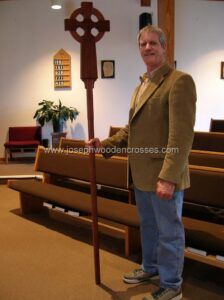 As highly decorative and bold in fashion as they were, the tradition of erecting these great Stone Monuments largely died out after the 12th century. It was not until the 19th century that a variety of movements and trends began a “Celtic Revival”. The revival was complex and multifaceted, occurring across many fields. One of the best known incarnations is probably the Irish Literary Revival (also called the “Celtic Twilight”) that stimulated a new appreciation of arts, poetry, literature, folklore, folk art, celtic wall art, celtic music, dance and theater with works of William Butler Yeats, Lady Gregory, Sir Samuel Ferguson or singer, songwriter Thomas Moore a novelist and playwrighter and poet Sir Walter Scott, and many others.
As highly decorative and bold in fashion as they were, the tradition of erecting these great Stone Monuments largely died out after the 12th century. It was not until the 19th century that a variety of movements and trends began a “Celtic Revival”. The revival was complex and multifaceted, occurring across many fields. One of the best known incarnations is probably the Irish Literary Revival (also called the “Celtic Twilight”) that stimulated a new appreciation of arts, poetry, literature, folklore, folk art, celtic wall art, celtic music, dance and theater with works of William Butler Yeats, Lady Gregory, Sir Samuel Ferguson or singer, songwriter Thomas Moore a novelist and playwrighter and poet Sir Walter Scott, and many others.
With the mysticism of story’s and folklore of medieval times long passed. Writers have no problem with the romantic movement of the Celtic Revival that inspired a great interest in the legends and tales of chivalry, such as in King Arthur with his sword Excalibur and the Knights of the Round Table. Beethoven even composed and produced a set of arrangements of Scottish folk-songs in the early 1800’s.
In jewelry, rings, pendent’s and brooches made of gold, silver, bronze, brass and wood art work are made decorated in celtic christian art style. Celtic triskele’s, spiraling interlace and other motifs of zoomorphic elements. In architecture a renewed interest in ornamental celtic art developed and celtic motifs began to be used in all sorts of contexts including architectural design. Thomas A. O’Shaughnessy, in the 1910’s, inspired by the Celtic art, redecorated Old St. Patrick’s Church in Chicago in the Celtic Revival style with ornamentation of stained-glass windows and interlace stencils modeled after the illuminations found in the Book of Kells. The building was added to the National Register of Historic Places in 1977 and described as the “cornerstone of Irish culture” in Chicago.
With all of the celtic arts, music, literature and poetry that we know of today, the re-introduction of the Celtic Cross or High Cross as used in medieval times centuries ago remains to be the most inspirational and impressionable contribution of the Celtic Revival.
View my collection of hand made Wooden Crosses.
In Summary
The Celtic Crosses is still a form of celtic christian religious art found in Monasteries, Cathedrals, Churches and Homes over most of the westernized world. Church crosses, home crosses, garden crosses, wedding crosses, memorial crosses, wood celtic wall crosses. Church services using ceremonial crosses and processional crosses and monumental funerary art as cemetery crosses.
Each of the wooden crosses I make is considered by others and myself a work of art. No art work leaves my shop until I am satisfied. This is my unconditional guarantee to you.
What can I say,,,,,, It’s a Celtic Thing.
